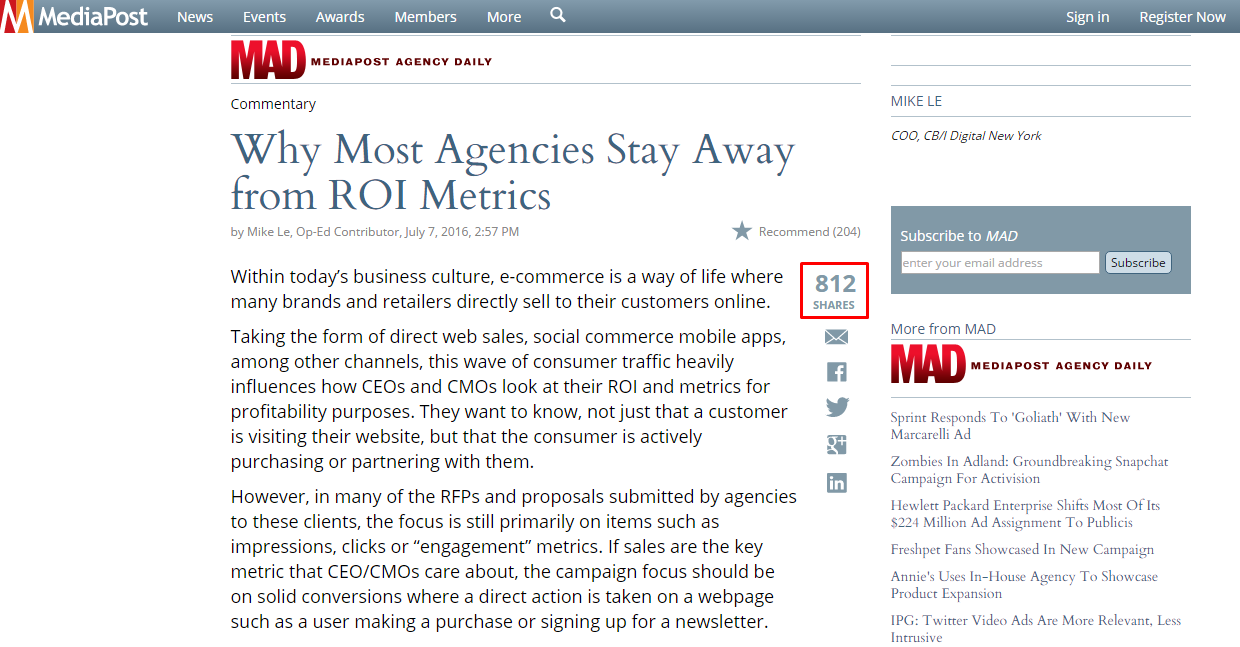Within today’s business culture, e-commerce is a way of life where many brands and retailers directly sell to their customers online.
Taking the form of direct web sales, social commerce mobile apps, among other channels, this wave of consumer traffic heavily influences how CEOs and CMOs look at their ROI and metrics for profitability purposes. They want to know, not just that a customer is visiting their website, but that the consumer is actively purchasing or partnering with them.
However, in many of the RFPs and proposals submitted by agencies to these clients, the focus is still primarily on items such as impressions, clicks or “engagement” metrics. If sales are the key metric that CEO/CMOs care about, the campaign focus should be on solid conversions where a direct action is taken on a webpage such as a user making a purchase or signing up for a newsletter.
With a focus on influencing the “right” audience, building brand awareness or being “top of mind” in the eyes of the consumer, many agencies skirt around providing clients with more concrete quantitative-driven results. They peddle the belief that a “deeply affected” and ‘influenced’ audience will be more likely to make a purchase later by simply getting the brand in front of them.
But Really, why Is That?
The honest answer is that achieving true conversion metrics is difficult. It is much harder to achieve conversion goals, and much harder to explain.
Harder to explain: Committing to “views” and “visits” is far easier to explain and communicate to clients than the algorithm behind what really makes a conversion happen and the variables involved. In digital advertising, a “view” is widely accepted as industry “currency,” especially when many clients are familiar with traditional advertising.
Harder to achieve: In order for an agency to achieve conversion goals instead of “views/visits” goals, they must be able to ensure that the right type of visitor lands on a client’s page. That’s because only relevant visitors can then take a specific “conversion” action. Thus, the expertise required to run a successful conversion campaign is high.
On the other side, if the goal is a view or click, agencies often look for lower cost-per-click channels to maximize the number of clicks and impressions. But the cheaper the traffic, the lower quality it is. The grey zone is that it is often difficult to evaluate the quality and relevancy of a “view” or “visit.”
Harder to commit: When committing to using conversions, one must rely on various unknown factors that are usually out of the agency’s control, such as price, promotion, distribution, and require a lot of testing to get it right.
Harder to communicate: It is difficult to handle the client communication through the ups and downs of conversion-oriented campaigns. That means that when results are down, clients often panic and have trouble explaining these results to stakeholders or higher-level management. When results are up, clients want more – even if they are not feasible or achievable given realistic parameters.
Mohammed Ali once said, “When you are right, nobody remembers. When you are wrong, nobody forgets.”
Thus, agencies would ask: “Why make life complicated when we can all agree to some easy metrics?”
It takes courage to go after results, not easiness.
Setting up conversion targets takes extensive testing and time and relies heavily on a lot of variables. Many of these variables are unknown or often unstable. But in life, nothing worth waiting for comes easily.
This challenge is worthwhile for agencies and clients to go all-in for it, because that is the only approach that delivers a real business result.
Clients and agencies need to be working together to take the current state of business to the next level.
Here are some best practices for clients and agencies to run a successful performance-oriented campaign:
- Give agencies room (and budget) to complete fundamental testing and use a “test and scale” approach.
- Estimate what your conversion KPIs are early, but be flexible to adjust them after you start testing.
- Communicate and ensure that a client’s IT team can be prepared and be quick to respond to changes ‘on-the-fly’ – especially on landing pages and during the conversion process.
- Communicate early with higher management on the client side to ensure that approvals continue with little discrepancies throughout the longevity of the campaign. And importantly, allow for a campaign to have longevity.
- Create a frequent and healthy flow of transparent, open and honest communication between the agency and the client team, to quickly clear any problems that might arise.
- Clients should work with agencies that are willing to take on the challenges of creating campaigns with conversion goals. They should also be willing to give agencies room to work deeply, efficiently and effectively in order to obtain real results.
Aiming for easiness, rather than effectiveness is harmful to all parties involved.
The conversion-centric mindset pushes people to think. This mindset pushes people to analyze, to test and to take risks by allowing the process to get down and dirty in uncovering what really works and what does not.
Conversions are the only metric that truly matter.

